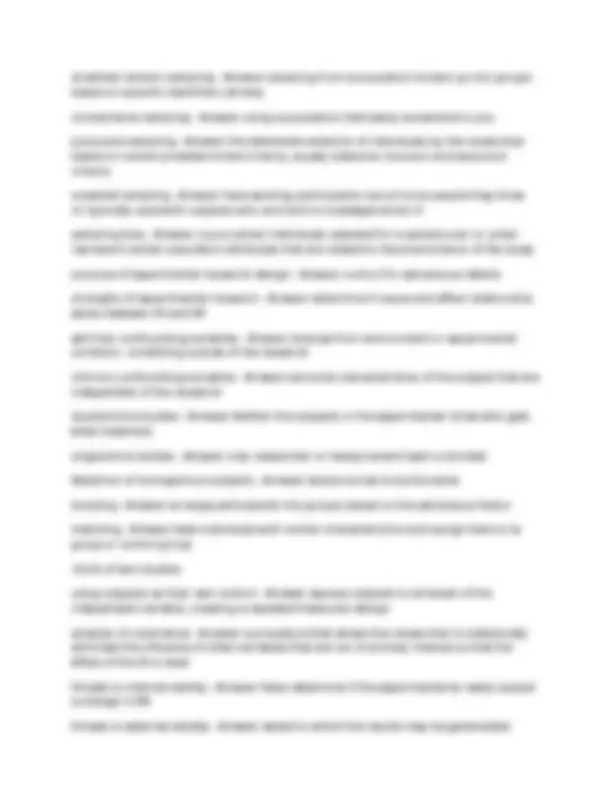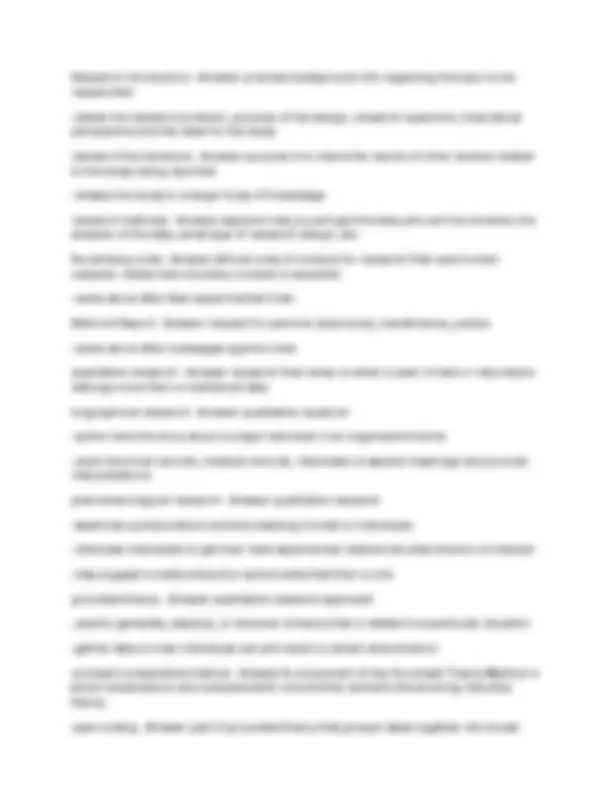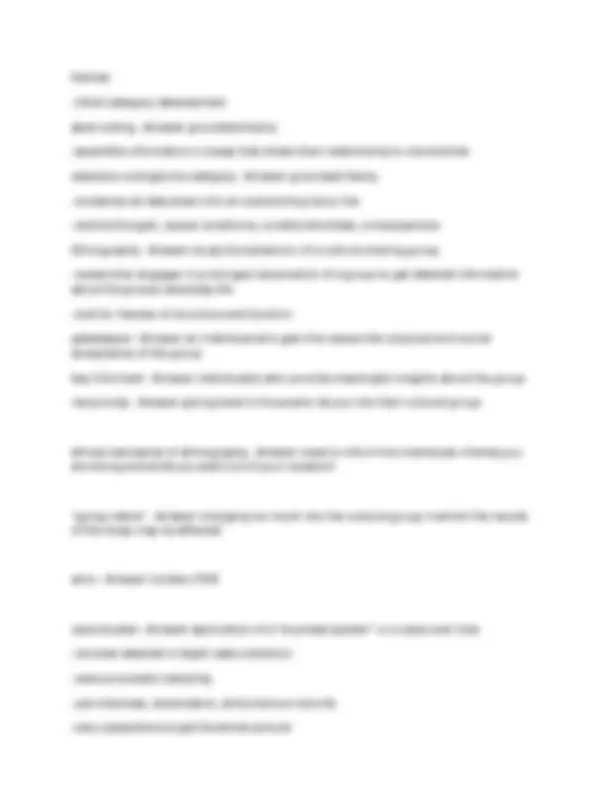






Study with the several resources on Docsity

Earn points by helping other students or get them with a premium plan


Prepare for your exams
Study with the several resources on Docsity

Earn points to download
Earn points by helping other students or get them with a premium plan
Community
Ask the community for help and clear up your study doubts
Discover the best universities in your country according to Docsity users
Free resources
Download our free guides on studying techniques, anxiety management strategies, and thesis advice from Docsity tutors
OT 500 Midterm Exam Study Set...
Typology: Exams
1 / 8

This page cannot be seen from the preview
Don't miss anything!





true experimental design - Answer random assignment, tx group and control group, IV independently manipulated by researcher quasi-experimental design - Answer missing some factor that would make it a true experimental design -used in clinical reality pretest-posttest control group design - Answer a true experimental design where participants are placed into either a control group or tx group. receive pretest(O) then the intervention(X) followed by a post test(O) to measure the DV posttest-only control group design - Answer true experimental design in which participants are given a tx (X) followed by a posttest (O) to measure the DV. This test controls for pretest sensitization however you do not know if the groups are equivalent prior to the tx one-group pretest-posttest - Answer a single group is given a pretest(O) followed by the intervention (X) and a posttest (O). the difference between the pretest and posttest indicate success of the tx. Problems: hx, maturation, not comparing anything -quasi-experimental design nonequivalent pretest-posttest control group design - Answer quasi-experimental design. similar to pretest-posttest control group design except the participants are not randomly assigned to the groups. Problems: self selection to groups one-group posttest-only design - Answer quasi-experimental design in which one group is given an intervention(X) then a posttest (O). Problems: did tx make a change?, no control group, threats to internal validity nonequivalent posttest-only control group design - Answer quasi-experimental design. one group gets the tx (X) and the control group does not and both groups are posttested (O). Problems: no pretest to determine if IV caused outcomes, selection bias. Only good for exploratory research. Time series design - Answer multiple measures taken before and after tx to document patterns or trends of behavior single factor designs for repeated measures - Answer -one-way repeated measures design over time -crossover design one-way repeated measures design over time - Answer -used when you can't find a control group
-assess effects of tx (X) by comparing patterns of pretest and posttest scores of one group of participants -does not control for hx crossover design - Answer -reduces the between pt variability because the comparison of tx A vs B is made on the same patient -good when tx effects are immediately reversible -need a washout time, only appropriate with chronic conditions, need to consider if the different tx will impact each other A-B design - Answer baseline followed by treatment A-B-A design - Answer single-subject study -baseline> intervention> baseline A-B-A-B design - Answer single-subject design -two intervention phases and two baseline phases -if you can replicate the results in the two phases then it is strong evidence A-B-C-A design - Answer single-subject, multiple tx design -baseline>tx A>baseline> tx B> baseline> tx C -looks at the effects of different tx or a tx and placebo inclusion criteria - Answer define characteristics an individual must have to participate in the research study exclusion criteria - Answer define characteristics a person must not have in order to participate target population - Answer a specific population in which you plan to generalize the results to accessible population - Answer portion of the target population to which the researcher has reasonable access sample - Answer subset of the population simple random sampling - Answer unbiased, everyone has an equal chance of being selected to the study systematic sampling - Answer use when you have a prenumber or alphabetized list -ex: every nth person is selected
Research introduction - Answer provides background info regarding the topic to be researched -states the research problem, purpose of the design, research questions, theoretical perspective and the need for the study review of the literature - Answer purpose is to share the results of other studies related to the study being reported -relates the study to a larger body of knowledge research methods - Answer explains how you will get the data, who will be involved, the analysis of the data, what type of research design, etc. Nuremberg code - Answer ethical code of conduct for research that uses human subjects. states that voluntary consent is essential -came about after Nazi experimental trials Belmont Report - Answer respect for persons (autonomy), beneficence, justice -came about after tuskeegee syphilis trials qualitative research - Answer research that relies on what is seen in field or naturalistic settings more than on statistical data biographical research - Answer qualitative research -author tells the story about a single individual in an organized timeline -uses historical records, medical records, interviews to explain meanings and provide interpretations phenomenological research - Answer qualitative research -examines a phenomenon and the meaning it holds to individuals -interview individuals to get their lived experiences relative the phenomenon of interest -may suggest a relationship but cannot state that their is one grounded theory - Answer qualitative research approach -used to generate, develop, or discover a theory that is related to a particular situation -gather data on how individuals act and react to certain phenomenon constant comparative method - Answer A component of the Grounded Theory Method in which observations are compared with one another and with the evolving inductive theory. open coding - Answer part of grounded theory that groups ideas together into broad
themes -initial category development axial coding - Answer grounded theory -assemble information in a way that shows their relationship to one another selective coding/core category - Answer grounded theory -condense all data down into an overarching story line -central thought, causal conditions, condition/context, consequences Ethnography - Answer study the behaviors of a culture-sharing group -researcher engages in prolonged observation of a group to get detailed information about the groups everyday life -look for themes of structure and function gatekeeper - Answer an individual who gets the researcher physical and social acceptance of the group key informant - Answer individual(s) who provide meaningful insights about the group reciprocity - Answer giving back to those who let you into their cultural group
ethical standards of ethnography - Answer need to inform the individuals of what you are doing and what you want out of your research
"going native" - Answer indulging too much into the cultural group in which the results of the study may be affected
emic - Answer insiders POV
case studies - Answer exploration of a "bounded system" or a case over time -involves detailed in depth data collection -uses purposeful sampling -use interview, observation, and previous records -very subjective but get the whole picture
testing - Answer Participants who take a pre-test may learn from the experience in a way that influences their post-test results -threats to internal validity
instrumentation - Answer changing the instruments used within the study, a change in observers, or scorers which produce changes to the outcomes -threats to internal validity
experimental mortality - Answer occurs when some of the research participants leave the experiment midway through -threat to internal validity
statistical regression - Answer All variables examined are continuous. Makes assumptions about which variable is influencing the other -threat to internal validity
selection - Answer any factors (except the program) that may lead to posttest differences between the groups -threat to internal validity
diffusion or imitation of treatment - Answer refers to a situation where the control group learns information about the program from the experimental group of participants which often leads to the posttest performance by the control group being altered -threat to internal validity
compensatory rivalry - Answer When the control group receives either a lesser form of treatment or no treatment at all, this can create a rivalry to do/perform better than the actual treatment group -threat to internal validity
resentful demoralization - Answer This is when the participants in the control group find
out what the treatment group is getting. This causes the control group to get angry and even give up -threat to internal validity
Compensatory equalization of treatment - Answer comparison groups not obtaining the preferred treatment are provided with compensations that make the comparison groups more equal than originally planned -threat to internal validity
reactive effect of pretesting - Answer Pretesting can influence how participants respond to experimental treatment -threat to external validity
Reactive effects of experimental procedures and the "Hawthorne Effect" - Answer participants become aware they are being observed, causing them to modify their behavior as a result -threat to internal validity
multiple treatment interference - Answer when the administration of more than one treatment to the same group of test subjects can affect one another. The effects of one treatment can affect the outcomes of the other treatment -threats to external validity